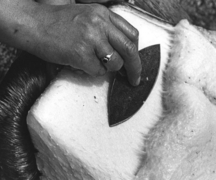Ammerineq
Knowledge of skin treatment

Traditional methods of treating and curing skins in Greenland extend 4,500 back in history. This ancient knowledge, handed down from generation to generation, is still present to some extent in Greenlandic society.
The skin was not the only part of the animal to be used. Sinews, gullets, membranes and the stomach of different animals were used to make sewing thread, drum skins, and various receptacles.
Once everyday articles and clothing made of and with animal skins are complete and in use they continue to be treated to retain their properties.
A key basis for the survival of Inuit cultures in Greenland was their knowledge of treating and curing the sealskin of five species of seal for different purposes, but all animal skins were treated and used, especially in clothing. The warmest skins from reindeer and arctic foxes required different forms of treatment. Bird skins, bearskin and the fur of hares and dogs were also cured and used in clothing.

